For me, any container design starts with the container itself and this continues to be my greatest frustration. Good containers are difficult to find and for some reason they seem particularly difficult to find anywhere near me.
My biggest beef with most of the containers that are readily available is that they are just not big enough. I have almost no use for small containers. They dry out too quickly and it is very hard to make a proper display in them, unless they destined for the top of a patio table or grouped with other containers of varying sizes. A neighbor has asked me to help them out and do their container plantings this year (in the past he has taken his containers to a local nursery to plant them at great expense and with a great deal of hassle) and for the last 35 years they have planted red geraniums in 6- to 8-inch terracotta pots on their windowsill. I’m not going to mess with that kind of tradition, but the whole idea just makes me cringe. That’s basically a multiple-times-a-day watering situation.
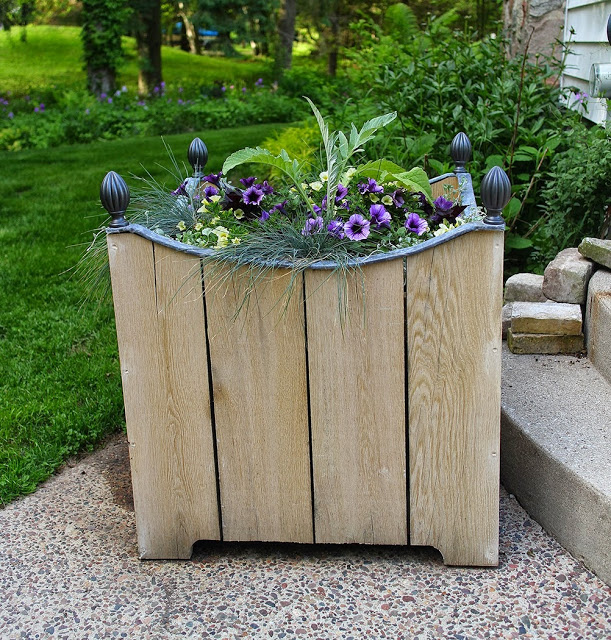 |
| The wood planter box with lead trim that we built for the area by the front door is huge, just the way I like my containers. |
So size comes first for me. What surrounds the area near the container is a huge factor because it all has to be in scale. That’s why the wood container we built near the front door is such a behemoth: With the door at the top of four steps, the entryway gets very tall and balance dictates that whatever is planted there be tall enough to make sense. If containers are to be located near a walkway, I want them to be tall enough that they don’t reach out and grab the middle of your calf as you walk by.
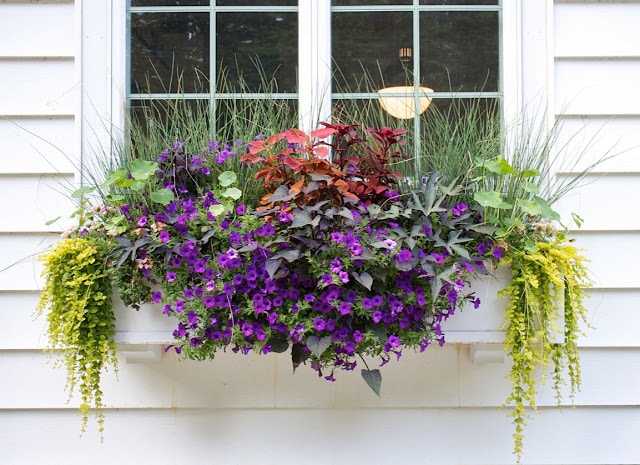 |
| My window box is the same size as the window, measuring out to the trim, but I wish I would have gotten one slightly larger. |
For window boxes, I subscribe to Deborah Silver’s theory that they should be larger than the window, extending out a few inches on either side of a window or to the outside edge of shutters. Our window box is about the same size as the window and I wish I would have gone slightly larger.
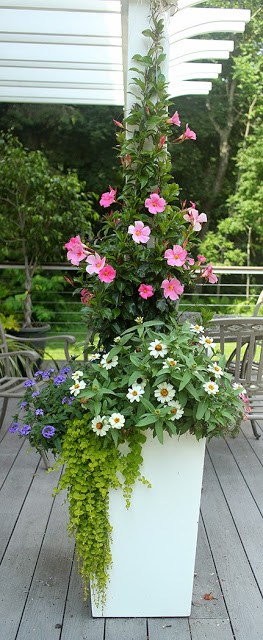 |
| The white fiberglass pots on the deck were chosen to blend in with the pergola posts. |
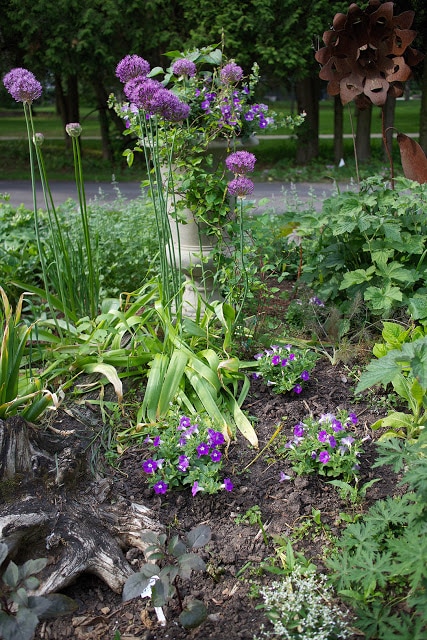 |
| You can see a peek of the just-planted urn that lives in the middle of the patio garden. |
After you’ve figured out a rough size, the next step is design. I’ll be honest, I struggle with this aspect of container selection the most. I’m never really sure what my “style” is and what works best with my house. I like a little bit of modern, a little bit of classic and tiny bit of cottage, but I’m never really sure how all of this meshes together. At the same time, I can’t imagine ever being happy limiting myself to one kind of container. I have a sort of Belgian-inspired oak and lead container by the front door, a simple-lined urn in the middle of the patio garden, a rather formal zinc planter by the garage, modern white fiberglass planters on the deck, a wood trough by the back steps and a terracotta pot for the containerized rose that roams around the garden where it is most needed. Do all these styles work together? I’m not entirely sure, but for now, they work for me and that’s my first rule of gardening: If it works for you, it works for the garden.
I think the style of the house or structure a container will be near is probably the biggest factor in figuring out a style. The next decision is whether you want the container itself to be the feature or if you want it to blend in and allow the plants to be the star of the show. The white fiberglass planters on my deck were chosen because they blend in with the pergola posts, to the point where you almost don’t notice them.
Then there are practical concerns. Do you intend to leave this container in place year round and live in an area where it freezes? Then you are going to be limited on what you can use. If you plan to move containers for winter, how much weight are you willing to lug around?
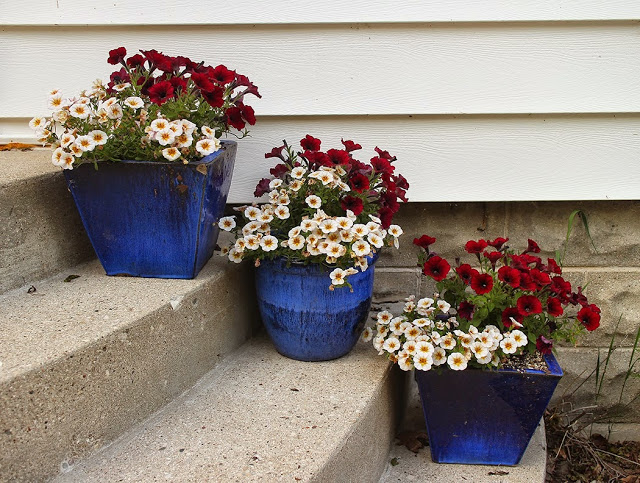 |
| I like these pretty blue glazed ceramic containers, but even these small pots are a hassle to move around because they are so heavy. |
I used to love glazed ceramic pots, which are readily available at nurseries near us. I still use a few by the front door (another style of pot I forgot to mention above), but even they are not fun to move. They will crack at the first sign of a freeze if left outside with dirt in them, so moving them was required. When the last large one broke during a move several years ago, I swore them off not because I don’t like them but because they were too high maintenance for me. Terracotta pots have the same problem, although there are some kinds of Italian pots that will withstand freezing temperatures, but they are very pricey.
Fiberglass pots will withstand a freeze and are nice and light, but do be aware that you can easily poke a hole in one if you’re not careful. Metal containers are also (usually) freeze-proof (most say frost resistant but I think they are covering their butts), but I worry about the soil temperatures in them: hot in summer and cold in winter. Fiberclay or faux cement pots are very good: lightweight, frost proof, durable and good looking. Plastic containers can be great or they can be horrible, but they shouldn’t be dismissed outright. I have a tall plastic container in front of the office that looks a lot like the fiber cement containers and has held up well.
And last there is price. It is mind-boggling to me how expensive some containers are. I have bought more than a few that have made me a little sick about spending that kind of money on them. And although I tend to have a fair amount of buyer’s remorse after I make these purchases, they’ve turned out to be great long-term investments. All are still in service after several years and showing no signs of wear and if I decided that I no longer needed one, I think I could probably sell it used for a pretty good price. A lot of people are looking for high-quality containers with good style.
The biggest mistake I think you can make when shopping for containers is to not buy one that is big enough. I know there is an inclination to buy a smaller pot because it’s less expensive than a bigger one, but it will never be quite right if it’s not the right size.
Ready to find the perfect container? Check here for some containers at a range of prices: From bargain shopper to put-it-in-your-will.
What would you like to know? Search, or jump to categories below.
3 Responses
It's about that time! And I've been thinking the same thing after losing one of my favourite concrete containers. I need something taller for a spot by the garage door – but not so tall that it interferes with the window box above it.
By the way, I love your advice about the size of the window box – making it larger makes so much sense. It's like you're hanging a floral valance on the bottom of the window. With a real valance across the top, you would always extend it out a bit. Love it!
We don't have room for many containers but I've decided I like the Great Dixter approach of one plant per pot. Most of our pots are stonewate and live in the garden as sculpture with no plants in them.
A lot of food for thought, here! I need to spend more time thinking about containers, I think…